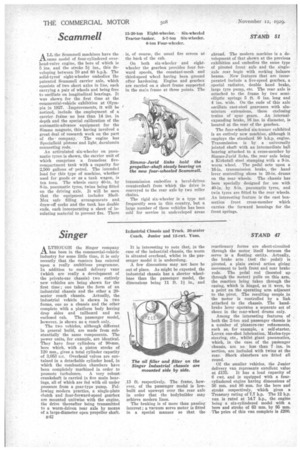Singer
Page 180

If you've noticed an error in this article please click here to report it so we can fix it.
A LTHOUGH the Singer company 2-1 has been in the commercial-vehicle industry for some little time, it is only recently, .that the concern has entered upon a really ambitious programme. In addition to small delivery vans (which are really a development of the private-car chassis) two entirely new vehicles are being shown for the first time; one takes the form of an industrial chassis and the other a 20
seater coach chassis. Actually, the industrial vehicle is shown in two forms, one as a chassis and the other complete with a platform body having drop sides and tailboard and an enclosed cab. The passenger model, however, is shown as a coach only.
The two vehicles, although different In general build, are made from substantially the same components. The power units, for example, are identical. They have four cylinders of 90-mm. bore which, with a piston stroke of 120 mm., gives a total cylinder capacity of 3,053 c.c.. Overhead valves are contained in a detachable cylinder head, in which the combustion chambers have been completely machined in order to promote turbulence. A very robust crankshaft is carried in five main bearings, all of which are fed with oil under pressure from a gear-type pump. Following modern practice, a single-plate clutch and four-forward-speed gearbox are mounted unitwise with the engine, the drive thereafter being transmitted to a worm-driven rear axle by means of a large-diameter open propeller shaft.
E42 It is interesting to note that, in the case of the industrial chassis, the worm is situated overhead, whilst in the passenger model it is underslung.
A few dimensions may not here be out of place. As might be expected, the industrial chassis has a shorter wheelbase than the passenger model, the dimensions being 11 ft. 11 in., and
13 ft. respectively, The frame, however, of the passenger model is lowbuilt and upswept over the rear axle in order that the bodybuilder may achieve modern lines.
The braking is of more than passing interest ; a vacuum servo motor is fitted in a special manner so that the reactionary forces are short-circuited through the motor itself because the servo is a floating entity. Actually, the brake arm (not the Pedal) is pivoted, a plain swivel action giving movement to both front and rear brake rods. The pedal rod (boosted up through the motor) pulls on this arm, the reaction being taken through the casing, which is hinged, as it were, to a point on the operating arm adjacent to the pivot. The resulting couple in the motor is controlled by a link attached to the chassis. The handbrake lever operates a separate set of. shoes in the rear-wheel drums only.
Among the interesting features of both the 2-ton and passenger chassis is a number of pleasure-car refinements, such as, for example, a self-starter, Luvax one-shot lubrication, Manes-type steering, etc., whilst giant pneumatics, which, in the case of the passenger chassis, are no less than 7 ins, in section, are included with twins at the rear. Shock absorbers are fitted all round.
Of the smaller vehicles, the Junior delivery van represents excellent value at £135. It has a load capacity of 6 cwt. and is equipped with a fourcylindered engine having dimensions of 56 mm. and 86 mna, for the bore and stroke respectively, which gives a Treasury rating of 7.7 h.p. The 12 h.p. van is rated at 14.7 h.p., the engine being a six-cylindered model with a bore and stroke of 63 mm. by 95 mm. The price of this van complete is £200.








































































































































































































































































































































